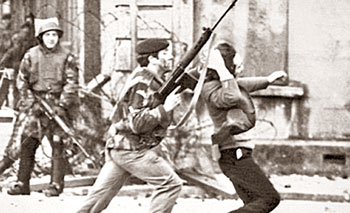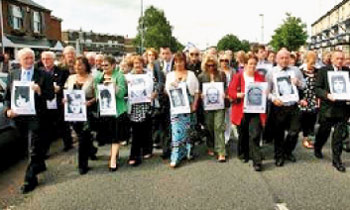No army is immune from leaving skeletons inside cupboards
Thirteen innocent civilians shot and killed by
British troops:
Saville Report on Bloody Sunday in Northern Ireland:
 On January 30th 1972, British paratroopers opened fire - or were
forced to do so, according to their account, after being fired at, at
first - on a civil right march in Londonderry in Northern Ireland, the
part of Irish territory that is under British rule. A total of 13 people
were killed in the incident and it triggered off a chain of disasters in
the long run. On January 30th 1972, British paratroopers opened fire - or were
forced to do so, according to their account, after being fired at, at
first - on a civil right march in Londonderry in Northern Ireland, the
part of Irish territory that is under British rule. A total of 13 people
were killed in the incident and it triggered off a chain of disasters in
the long run.
The 10000-odd protestors were up in arms against a law that had been
brought in to imprison suspects who were involved in subversive
activities against the state without trial. So, the government had
banned the march which went ahead defying the authority.
The paratroopers, on being pelted with stones, initially fired rubber
bullets, water cannons and tear gas to disperse the crowd. Paratroopers
were deployed with clear orders to arrest as many as possible; however,
at dusk, the atmosphere turned ugly. Paratroopers opened fire killing 13
and injuring a similar number. Then started the blame game: marchers
accused the army of firing indiscriminately; the soldiers, in turn,
accused the marchers of attacking them first.
The incident was the watershed of Northern Ireland troubles; it had
the potential to turn even those who didn’t want to form a united
Ireland by violent means, to embrace armed struggle as the only
solution. IRA, the main armed movement in the Northern Ireland, saw its
fortunes growing exponentially in terms of human resources, finances,
especially from the influential Irish community in America and
patriotism among the Irish.
Since then, there had been calls for public inquiries into the
incident. The British government, in the end, bowed to international
pressure and a few inquiries were launched in the past. However, none of
them could satisfy the grieving relatives of those who were killed; they
just saw them as a series of whitewash.
In this context, both the victims and the British government attached
huge significance to the latest report that was published on June 14th
by Lord Saville. It was a very damning report as far as the parachute
regiment was concerned, which was involved in the shooting. Some of the
major findings of the Saville report are as follows: Who got injured and
killed?
|

The near and dear of the 13 killed in aprotest relly in
Londonderry |
“None of the casualties shot by soldiers of Support Company was armed
with a firearm or (with the probable exception of Gerald Donaghey) a
bomb of any description. None was posing any threat of causing death or
serious injury. In no case was any warning given before soldiers opened
fire.
“None of the casualties was posing a threat of causing death or
serious injury, or indeed was doing anything else that could on any view
justify their shooting.”
Were the soldiers provoked by the IRA to commit the atrocities?
“We have concluded that the explanation for such firing by Support
Company soldiers after they had gone into the Bogside was in most cases
probably the mistaken belief among them that republican paramilitaries
were responding in force to their arrival in the Bogside. This belief
was initiated by the first shots fired by Lieutenant N and reinforced by
the further shots that followed soon after.”
Who fired the first shot?
“Soldiers reacted by losing their self-control and firing themselves,
forgetting or ignoring their instructions and training and failing to
satisfy themselves that they had identified targets posing a threat of
causing death or serious injury.”
Was this an act in self-defence or did paratroopers fire
indiscriminately?
“The soldiers fired because they lost control. He said with the
exception of two soldiers; none of the firing was aimed at people posing
a threat of causing death or serious injury”.
Were the soldiers properly prepared for the scenario?
“Soldiers of Support Company had been told by officers and believed
that this was a particularly dangerous area for the security forces,
with any incursion running the risk of meeting attacks by paramilitaries
using bombs and firearms; if these soldiers were not frightened, they
must at least have been highly apprehensive.”
Was there any evidence about disobeying superiors by the
paratroopers?
“The soldiers of Support Company who went into the Bogside did so as
the result of an order by Colonel Wilford, which should not have been
given and which was contrary to the orders that he had received from
Brigadier MacLellan.”
Did the army cover up the events of the fateful day?
“Apart from Private T many of these soldiers have knowingly put
forward false accounts in order to seek to justify their firing.” .
Did an, Irish republican hot-head fire the first shots?
“There was some firing by republican paramilitaries” but that on
balance the Army fired first. A member of the official IRA told the
inquiry that they had shot at soldiers very early on in retaliation to
the shooting of two of the protesters. These two official IRA members
had gone to a pre-arranged sniping position in order to fire at the
soldiers; and probably did so when an opportunity presented itself
rather than because two civilians had been injured.”
What was the role of Martin McGuinness, the leader of Sinn Fein in
all that?
“In the course of investigating the activities of the Provisional and
Official IRA on the day, we considered at some length allegations that
Martin McGuinness, at that time the Adjutant of the Derry Brigade or
Command of the Provisional IRA, had engaged in paramilitary activity
during the day. In the end we were left in some doubt as to his
movements on the day. Before the soldiers of Support Company went into
the Bogside he was probably armed with a Thompson sub-machine gun, and
though it is possible that he fired this weapon, there is insufficient
evidence to make any finding on this, save that we are sure that he did
not engage in any activity that provided any of the soldiers with any
justification for opening fire.”
Was the British government responsible for the deaths?
“The immediate responsibility for the deaths and injuries on Bloody
Sunday lies with those members of Support Company whose unjustifiable
firing was the cause of those deaths and injuries.”
Did the British government encourage the soldiers to send a clear
message to trouble-makers?
“In the months before Bloody Sunday, genuine and serious attempts
were being made at the highest level [of the British government] to work
towards a peaceful political settlement in Northern Ireland. Any action
involving the use or likely use of unwarranted lethal force against
nationalists on the occasion of the march (or otherwise) would have been
entirely counterproductive to the plans for a peaceful settlement; and
was neither contemplated nor foreseen by the United Kingdom government.”
Did the Northern Ireland government covertly contribute to the
violence?
“So far as the Northern Ireland government was concerned, although it
had been pressing the United Kingdom government and the Army to step up
their efforts to counter republican paramilitaries and to deal with
banned marches, we found no evidence that suggested to us that it
advocated the use of unwarranted lethal force or was indifferent to its
use on the occasion of the march.”
Were the paratroopers just trigger-happy or there any shoot-to-kill
policy?
“It was also submitted that in dealing with the security situation in
Northern Ireland generally, the authorities (the United Kingdom and
Northern Ireland governments and the Army) tolerated if not encouraged
the use of unjustified lethal force; and that this was the cause or a
contributory cause of what happened on Bloody Sunday. We found no
evidence of such toleration or encouragement.”
The damning report, comprising 5000 pages, took almost 12 years to
produce. It certainly put both the government and the army in a
precarious position. David Cameron, the British prime minister said “it
was shocking and he is deeply sorry,” while delivered the findings.
It is highly likely that the soldiers who were on duty on Bloody
Sunday may be prosecuted in the light of the Saville report. If the
situation develops that far, it is like taking the lid off a can of
worms; plenty of ugly things that lie under the fragile peace agreement
between the British government and the IRA may come up - only to burden
the peace agreement which is already at the breaking-point with the last
straw.
Courtesy: Asian Tribune
|

